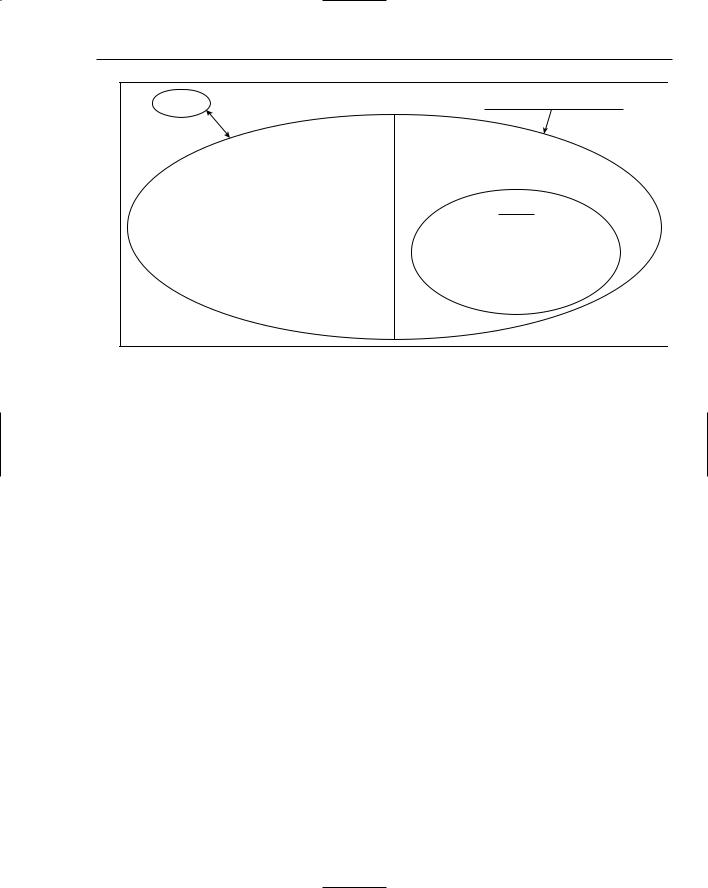
Professional Java.JDK.5.Edition (Wrox)
.pdf
Chapter 7
<tr>
<td valign=”top”>
<a href=””>Test1</a><br> <a href=””>Test2</a><br>
</td>
</tr>
</table>
These tag files can be important components for header and footer implementations that contain common information that can be easily propagated to the Web pages in your project.
JSP Page Extensions (*.jspx)
Java Server Pages that have *.jspx extensions are meant to advocate the use of XML syntax to generate XML documents in JSP 2.0 compliant Web containers.
The code specified below describes how jspx files can be implemented when you develop Web applications to generate user displays:
<!--forms.jspx ‡ <?xml version=”1.0”?>
<tags:test xmlns:tags=”urn:jsptagdir:/WEB-INF/tags” xmlns:jsp=”http://java.sun.com/JSP/Page” xmlns:c=”http://java.sun.com/jsp/jstl/core” xmlns=”http://www.w3.org/1999/xhtml”>
<jsp:directive.page contentType=’text/html’/> <head><title>Form Test</title></head>
<body>
<c:choose>
<c:when test=’${param.name == null} and ${param.address == null}’> <form action=”form.jspx”>
Please enter your name and address:<br/> <input name=”name” size=”40”/><br/> <input name=”address” size=”40”/><br/> <input type=”submit”/>
</form>
</c:when>
<c:otherwise>
User entered name=${param.name}, address=${param.address}<br/> </c:otherwise>
</c:choose>
</body>
</tags:test>
The test.tag file below is used to invoke the JSP fragments using the <jsp:doBody> standard action:
<!DOCTYPE html PUBLIC “-//W3C//DTD XHTML Basic 1.0//EN” “http://www.w3.org/TR/xhtml-basic/xhtml-basic10.dtd”> <html xmlns=”http://www.w3.org/1999/xhtml”> <jsp:doBody/>
</html>
336

Developing Web Applications Using the Model 1 Architecture
As the JSP 2.0 specification indicates, Web applications that contain files with an extension of .jspx will have those files interpreted as JSP documents by default.
Simple Invocation Protocol
This API enhancement was developed to exploit the use of scriptless pages among Web developers using JSP libraries in their development activities for implementing tag files.
In the code example below, the <lottery:picks/> tag file invocation demonstrates how simple it is to incorporate logic into a Web page using tag libraries:
<%@ taglib uri=”/WEB-INF/tlds/lottery.tld” prefix=”lottery” %> <html>
<head>
<title>Lottery Picks</title> </head>
<body>
<h2>Lottery Picks</h2>
Lottery number generated is...<lottery:picks/> </body>
</html>
The lottery tag library descriptor file, lottery.tld, outlines the lottery tag file application invoked from the preceding Web application:
<!--lottery.tld ‡
<?xml version=”1.0” encoding=”UTF-8” ?> <taglib xmlns=”http://java.sun.com/xml/ns/j2ee”
xmlns:xsi=”http://www.w3.org/2001/XMLSchema-instance” xsi:schemaLocation=”http://java.sun.com/xml/ns/j2ee/web-jsptaglibrary_2_0.xsd” version=”2.0”>
<description> Lottery picks </description>
<jsp-version>2.0</jsp-version>
<tlib-version>1.0</tlib-version> <short-name>picks</short-name> <uri></uri>
<tag>
<name>picks</name> <tag-class>lottery.LotteryPickTag</tag-class> <body-content>empty</body-content>
<description>Generate random lottery numbers</description> </tag>
</taglib>
The LotteryPickTag application below illustrates how the SimpleTagSupport class can be extended to allow developers to craft tag handlers. The doTag() method is invoked when the end element of the tag is realized. In the sample Lottery application, the getSixUniqueNumbers() method is called from the doTag method which in turn displays the string output of six unique lottery numbers generated in random fashion:
337

Chapter 7
package lottery;
import java.io.*; import java.util.*;
import javax.servlet.jsp.*;
import javax.servlet.jsp.tagext.SimpleTagSupport;
public class LotteryPickTag extends SimpleTagSupport {
public LotteryPickTag(){}
public void doTag() throws JspException, IOException { getJspContext().getOut().write(“Random #’s =” + getSixUniqueNumbers());
}
public String getSixUniqueNumbers() { StringBuffer sb = new StringBuffer(); int count = 0, number = 0;
int numbers[] = {0,0,0,0,0,0,0}; boolean found;
while (count < 6) {
number = (int)(Math.random()*59) + 1; found = false;
for (int i=0; i < numbers.length; i++)
if (numbers[i] == number) found = true; if (!found) {
if (count != 0) sb.append(“ - “); sb.append(number); numbers[count++] = number;
}
}
return sb.toString();
}
}
JSP tag files are converted into Java code by the JSP container in the same fashion that JSP scripts are translated into servlets. It should be fairly evident from this example how easily tag files can be constructed for deployment in Web components for enterprise systems because they hide the complexity of building custom JSP tag libraries, which makes them easier to maintain in the long run.
Figure 7-2 outlines visually some of the enhancements of the JSP 2.0 specification along with some of the backwards compatibility issues that are addressed in the JSP 2.0 specification.
Certainly, the JSP 2.0 upgrade, with its ready-made Expression Language implementations, along with improvements in Java Server Pages Standard Tag Libraries, will enhance developer’s abilities to build cohesive and robust Web components.
338

Developing Web Applications Using the Model 1 Architecture
JSP 1.2 |
|
Backwards compatibility issues |
||
extends |
|
Tag Library |
|
|
|
|
|
||
|
Servlet 2.4 |
Validation |
Tag coercion |
|
|
|
|||
|
Specification |
|
||
|
|
rule adherence |
||
Expression |
support |
I18N behavior |
||
|
||||
Language (EL) |
|
differences |
|
|
Support |
|
|
web.xml |
|
|
*.tag and *.tagx |
|
||
|
|
|
||
JSP page |
support for |
Lack of EL |
JSP interpretation |
|
reuse |
||||
support in JSP |
of *.jspx files by |
|||
extensions |
|
|||
|
1.2 pages |
default |
||
(*.jspx) |
|
|||
|
|
|
||
|
Simple Invocation |
‘/$’ support now |
||
|
Protocol for script- |
longer there, returns |
||
|
less pages |
|
‘$’ |
|
Figure 7-2
Integrated Expression Language (EL)
The following section concentrates on the Expression Language (EL) and its implementation in JSP applications. Certainly, there is ample content in the JSP 2.0 specification to discuss and demonstrate, especially some of the Servlet 2.4 features that were discussed briefly above, but this section will concentrate on EL implementations because they are exploited prominently in the Contact Management Tool. Some of the other aspects of that specification are fairly involved and extend beyond the scope of this chapter.
Expression Language (EL) expressions can be used with three different attribute values. First, they can be applied when an attribute value has a single expression; second, they can be used when the attribute value contains one or more expressions surrounded or separated by text; and lastly, they can be used when the attribute value contains only text. The table below shows how these operations can be implemented.
EL Expressions |
Implementation |
|
|
Single expression |
<xyz.tag value=”${expression}”/> |
One or more expressions |
<xyz.tag value=”abc${expression}text${expression}”/> |
Text only |
<xyz.tag value=”abc text”/> |
|
|
339

Chapter 7
JSP 2.0 scripts allow EL expressions to perform conditional operations on your Web page variables. An example of this follows:
<c:if test=”${param.Comments > 250}”>
</c:if>
The parameter param.Comments is checked to see if it is greater than 250; if so, then the logic that lies between the if statement is executed.
The JSTL core tag libraries can also be used for variable output. Here is an example of this:
<c:out value=”${testELexpression}”/>
JSP 2.0 pages implement several different implicit objects through EL expressions; the table below lists some examples.
Implicit Object |
Description |
|
|
pageContext |
Accesses the PageContext object, which provides access to all the |
|
namespaces associated with a JSP page |
pageScope |
A Map that contains page-scoped attribute names and values |
requestScope |
A Map that contains request-scoped attribute names and values |
sessionScope |
A Map that contains session-scoped attribute names and values |
applicationScope |
A Map that contains application-scoped attribute names and values |
Param |
A Map that correlates parameter names to single String parameter |
|
values |
paramValues |
A Map that correlates parameter names to a String[] of all values of |
|
that parameter |
header |
A Map that contains header names in a String |
headerValues |
A Map that contains header names in a String array component |
Cookie |
A Map that contains Web cookie objects |
initParam |
A Map that holds context initialization parameter names and their |
|
values |
|
|
Implicit objects, for example, objects that don’t need to be declared and are declared automatically, allow developers to access Web container services and resources.
JSTL 1.1 Overview
Capabilities of the Java Standard Template Library (JSTL 1.1) specification are too numerous to elaborate on in great depth, so this chapter will concentrate on two tag library capabilities that are helpful in the sample Contact Management Tool (CMT). The CMT application persists data in a MySQL database during storage and retrieval operations so that the SQL Actions libraries are implemented and the Function Tag Library operations are used for string manipulation. So the latter will be discussed too.
340

Developing Web Applications Using the Model 1 Architecture
Function Tag Library
The Function Tag Library capabilities were introduced with the JSP 2.0 specification to allow developers to extend Expression Language (EL) functionalities with string manipulation libraries. The JSTL 1.1 specification outlines these functions as follows. The following table demonstrates some of the new method functions available as part of the expression language support in JSP 2.0.
Function [fn:] |
Description of Function |
|
|
fn:contains(string, substring) |
If the substring exists in a specified string value, true |
|
will be returned to the user, otherwise false. |
|
Example, fn:contains(“independence”, “depend”) |
|
returns true |
fn:containsIgnoreCase(string, substring) |
Ignoring case differences, if a substring exists in a |
|
specified string value, true will be returned to the |
|
user, otherwise false. |
|
Example, fn:containsIgnoreCase(“independence”, |
|
“DEPEND”) returns true |
fn:endsWith(string, suffix) |
Tests the end of a string with the suffix specified to |
|
determine if there is a match. |
|
Example, fn:endsWith(“whirlyjig’, “jag”) returns |
|
false |
fn:escapeXml(string) |
Escape characters that might be XML |
|
Example, fn.escapeXml(“<test>yea</test>”) returns |
|
converted string |
fn:indexOf(string, substring) |
Returns integer value of the first occurrence of the |
|
specified substring in a string. |
|
Example, fn:indexOf(“democratic”, “rat”) returns 6 |
fn:join(array, separator) |
Joins elements from an array into a string with a |
|
specified separator |
|
Example, array[0]=”X”, array[1]=”Y” |
|
fn:join(array,”;”) returns String = “X;Y” |
fn:length(item) |
Returns a collection count or the number of charac- |
|
ters in a string as an integer value |
|
Example, fn.length(“architecture”) returns 12 |
fn:replace(string, before, after) |
Returns a new string after replacing all occurrences |
|
of the before string with the after string. |
|
Example, fn:replace(“downtown”, “down”, “up”) |
|
returns uptown |
fn:split(string, separator) |
Returns an array where all the items of a string are |
|
added based on a specified delimiter |
|
Example, fn:split(“how now brown cow”,” “) |
|
returns |
|
array[0]=”how”, array[1]=”now”, |
|
array[2]=”brown”, array[3]=”cow” |
|
|
|
Table continued on following page |
341

Chapter 7
Function [fn:] |
Description of Function |
|
|
fn:startsWith(string, prefix) |
Returns a boolean value (true/false) depending on |
|
whether or not a string contains a specified prefix |
|
value |
|
Example, fn:startsWith(“predicament”, “pre”) |
|
returns true |
fn:substring(string, begin, end) |
Returns a substring of a string based upon specified |
|
index values |
|
Example, fn:substring(“practical”, 2,5) returns act |
fn:substringAfter(string, substring) |
Returns a string value that follows a specified |
|
substring |
|
Example, fn:substringAfter(“peppermint”,”pepper”) |
|
returns mint |
fn:substringBefore(string, substring) |
Returns a string value that precedes a specified sub- |
|
string value |
|
Example, fn:substringBefore(“peppermint”, “mint”) |
|
returns pepper |
fn:toLowerCase(string) |
Converts all the characters of a specified string to |
|
lowercase |
|
Example, fn:toLowerCase(“Design Patterns”) |
|
returns design patterns |
fn.toUpperCase(string) |
Converts all the characters of a specified string to |
|
uppercase |
|
Ex., fn:toUpperCase(“Patterns”) returns PATTERNS |
fn:trim(string) |
Eliminates leading and trailing white space from a |
|
specified string |
|
Example, fn:trim(“ almost done “) returns “almost |
|
done” |
|
|
Since text manipulation is so prevalent in Web applications, these function libraries are invaluable components for your development and deployment operations. Many of these functions mirror the same APIs that the Java String class possesses, so they should be learned fairly easily.
SQL Actions
A general rule of thumb for SQL transactions on enterprise systems is to handle database operations within business logic operations; we’ll demonstrate that with the Add Contact component below. But, sometimes you might want to perform those activities with the SQL tag libraries that are part of the JSTL 1.1 libraries.
JSTL SQL Actions allow developers to interact with databases on the presentation layer. An overview of its capabilities include the ability to perform queries through select statements, database updates with insert, update, and delete operations, and transactional activities that allow the aggregation of database operations.
342

Developing Web Applications Using the Model 1 Architecture
The following table illustrates the SQL Action tags for establishing a data source.
Tag |
Description |
<sql:setDataSource> |
This tag exports a data source. |
|
<sql:setDataSource |
{datasource=”dataSource” | url = “jdbcUrl”
[driver = “driverClassName”] [user = “userName”] [password = “password”] } [var=”varName”]
[scope=”{page|request|session|application}”]/>
The following table illustrates the SQL Action tags for query operations.
Tag |
Description |
|
|
<sql:query> |
This tag queries the database. |
|
Without body content |
|
<sql:query sql=”queryString” |
|
var=”varName” |
|
[scope=”{page|request|session|application}”] |
|
[maxRows=”maxRows”] |
|
[startRow=”startRow”] /> |
|
With a body for query parameters |
|
<sql:query sql=”queryString” |
|
var=”varName” |
|
[scope=”{page|request|session|application}”] |
|
[maxRows=”maxRows”] |
|
[startRow=”startRow”] |
|
<sql:param> actions |
|
</sql:query> |
|
With a body for query parameters and options |
|
<sql:query sql=”queryString” |
|
var=”varName” |
|
[scope=”{page|request|session|application}”] |
|
[maxRows=”maxRows”] |
|
[startRow=”startRow”] |
|
query optional |
|
<sql:param> actions |
|
</sql:query> |
|
|
343

Chapter 7
The following table illustrates the SQL Action tags for update operations.
Tag |
Description |
|
|
<sql:update> |
This tag executes an INSERT, UPDATE, or DELETE statement. |
|
Without body content |
|
<sql:update sql=”updateString” |
|
[datasource=”datasource”] |
|
[var=”varName”] |
|
[scope=”{page|request|session|application}”]/> |
|
With a body for query parameters |
|
<sql:update sql=”updateString” |
|
[datasource=”datasource”] |
|
[var=”varName”] |
|
[scope=”{page|request|session|application}”] |
|
<sql:param> actions |
|
</sql:update> |
|
With a body for query parameters and options |
|
<sql:update sql=”updateString” |
|
[datasource=”datasource”] |
|
[var=”varName”] |
|
[scope=”{page|request|session|application}”] |
|
update statement optional |
|
<sql:param> actions |
|
</sql:update> |
|
|
The SQL Action tags elaborated on above certainly are powerful mechanisms to perform SQL transactions inside your JSP Web components without having to worry about back-end JavaBean applications to perform the same duties. Ultimately, developers must decide during their coding operations if they opt to perform script or JavaBean queries in their deployments. Fortunately, the Contact Management Tool illustrates both to facilitate your design decisions.
Developing Your Web Application Visualizations with JSTL
Our code example below demonstrates the use of SQL actions mentioned previously. The first course of action in our code is to establish a data source object that will allow the application to connect to the picture database so that queries can collect data for visualization on your JSP page:
<%@ page language=”java” contentType=”text/html”
import=”java.util.*,java.lang.*,java.io.*” %>
<%@ taglib prefix=”c” uri=”http://java.sun.com/jstl/core_rt” %> <%@ taglib prefix=”sql” uri=”http://java.sun.com/jstl/sql” %>
<HTML><HEAD><TITLE>Contact Management Tool</TITLE> <link href=”CMT.css” rel=”stylesheet” type=”text/css”>
<sql:setDataSource
344

Developing Web Applications Using the Model 1 Architecture
var=”pictures”
driver=”org.gjt.mm.mysql.Driver”
url=”jdbc:mysql://localhost/picture”
user=””
password=””
scope=”page”/>
After the data source has been established, a query is performed using the database reference ${pictures} where the result set is stored in the results variable:
<sql:query var=”results” dataSource=”${pictures}”> select * from picture
</sql:query>
<br>
<br>
The result set variable is then used to iterate through the individual database entries so that they can be shown on the user display:
<table cellSpacing=0 cellPadding=4 align=center><tr><td bgColor=#7b849c> <table border=”0”><tr><td>
<c:forEach var=”row” items=”${results.rows}” varStatus=”counter”> <tr class=”row1”>
<td>
<table cellSpacing=”0” cellPadding=”0” border=”0”> <td valign=”top”><b>${counter.count}.</b></td> <td>
<table width=”500” border=”0”> <tr>
<td class=”smallblue” noWrap align=”middle”> <a href=””>${row.marking}</a>
</td>
<td>
<u>Attributes:</u>
</td>
</tr>
<tr>
<td align=”middle”> <a href=””>
<img src=”./images/${row.name}” width=50 border=0> </a>
</td>
<td>
<table>
<tr>
<td>Phone Number:</td> <td>${row.telephone_num}</td>
</tr>
<tr>
<td>Comments:</td> <td>${row.comments}</td>
345
